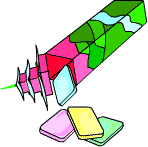Marzipan
Created | Updated Jul 15, 2002
Marzipan is the confectionery version of the potato waffle. Its waffly versatile- well, not waffly, more marzipany.
What is this thing? Is this some thing you do?
Marzipan is basically almonds reduced to a paste using sugar. It is used in many recipes today.  Its most recognised use is as a coating for traditional Christmas cakes. It is also used for sculpting. Due to its malleable yet stable structure, marzipan can be used to mould almost anything: from vegetables; to buildings; to Simon Shepherd or even Brian Blessed.
Its most recognised use is as a coating for traditional Christmas cakes. It is also used for sculpting. Due to its malleable yet stable structure, marzipan can be used to mould almost anything: from vegetables; to buildings; to Simon Shepherd or even Brian Blessed.
Marzipan is usually a dark yellow, but can be mixed with food colouring for added aesthetic value.
Origin
Marzipan is known to of originated from parts of the Orient,  where it was served as the crowning of a meal at the Sultan's table. During the crusades, it was imported into Venice, where it was distributed all across Spain and Germany as a delicacy.
where it was served as the crowning of a meal at the Sultan's table. During the crusades, it was imported into Venice, where it was distributed all across Spain and Germany as a delicacy.
When the Agricultural Revolution occured in the 19th century, sugar cane stock grew in abundance and marzipan was distributed and manufactured all across Europe as a common ingredient. Today, it is a forgotten and less valued item among many people- its only appearance being made at christmas, where is it sprawled over a gin-infested fruit cake. It is still a highly esteemed ingredient to most German confectioners and many older-generation housewives all over the world.
Johann Georg Niederegger
Johann Georg Niederegger is known to be the biggest entrepreneur of Marzipan in all of history. He set up a shop in the late 18th century where many highly esteemed aristocrats ate and socialised on a regular basis. His home city- Lubeck in Germany- is still established as the capital of all Marzipan franchise. Niederegger Lubeck Patisserie is still a working and successful business today.
